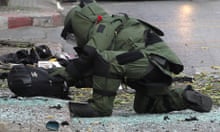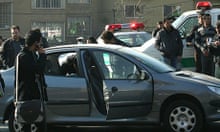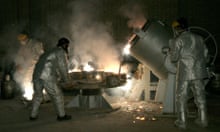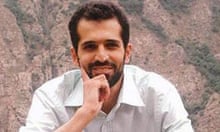Race Course Road in the centre of Delhi is one of the quieter roads in a city known for its chaotic traffic. Yet the scene at 3.15pm on 13 February was anything but calm.
A grey Toyota Innova people carrier was in flames with its two occupants, the wife of the Israeli defence attaché and her driver, on the ground nearby. Police and bystanders tried to call ambulances but none were available. More people milled around another vehicle, its windows blown in. As ever in India, there was much shouting, pushing and sirens. The perpetrator was already heading out of the country and back to Iran. His victims were put in a three-wheeled motorised rickshaw and sent to the nearest hospital.
The attack was one of three incidents over a 36-hour period that had taken at least 10 months to plan. On the day of the Delhi bombing – which involved a device the size of a large smartphone stuck to the side of the diplomatic car with magnetic strips – a second bomb was found attached to an Israeli diplomat's vehicle in Tbilisi, Georgia.
The day after, an explosion destroyed much of a house in a lane off the central Sukhumvit Road in Bangkok. A 28-year-old Iranian stumbled out and threw makeshift grenades at taxi drivers and police, before collapsing, badly injured. It did not take long for Iran to be blamed.
Rogue elements
The attacks followed months of escalating tension between Tehran and its enemies, particularly Israel. In the preceding weeks, Iran tested new missiles, boasted of breakthroughs in technology that could bring development of a nuclear weapon nearer, and threatened to shut down shipping in the Strait of Hormuz if further western sanctions were imposed over its nuclear programme. The EU responded by imposing new sanctions, including a curb on petroleum imports, the latest in a series of economic measures introduced since 2006 that had started to bite on the Iranian economy.
In October a bizarre plot to kill the Saudi Arabian ambassador in Washington had been uncovered by US authorities, blamed on possible "rogue" elements within the Iranian Revolutionary Guards.
Israel and the US were reported to have been behind a computer worm called Stuxnet, which infected the operating systems at Iran's uranium enrichment plant in Natanz and contributed to its temporary shutdown in November 2010.
A succession of attacks on Iranian nuclear scientists deepened the mood of mistrust. In November 2010 Majid Shahriari, a nuclear scientist, was killed and Fereydoon Abbasi Davani, Iran's atomic chief, survived an attack by assailants on motorcycles. In January this year, another prominent scientist, Mostafa Ahmadi-Roshan, died after a magnetic bomb was attached to his car, the same modus operandi as the Delhi bombing a month later.
"We will not neglect punishing those responsible for this act," Iran's supreme leader, Ayatollah Ali Khamenei, said after Ahmadi-Roshan's death. General Masoud Jazayeri, the spokesman for Iran's joint armed forces staff, said simply: "The enemies of the Iranian nation, especially the United States, Britain and the Zionist regime, or Israel, have to be held responsible for their activities."
An editorial in a hardline newspaper close to Khamenei said ominously that Iran had long experience of conducting assassinations overseas and was well-placed to extract revenge.
Shadow war
It is not known when or by whom the plots were conceived. But investigators in Delhi and Thailand know when those involved began preparations. Houshang Afshar Irani, the man accused of the Delhi bombing, first arrived in the Indian capital on 25 April 2011.
Irani stayed in Delhi for three weeks, leaving in mid-May. Based at a mid-priced hotel in the city's central Connaught Circus, he spent hours, investigators say, researching possible targets. They say he also spent time with at least three call girls, contacted through an intermediary who had placed advertisements in local newspapers.
The first visit to Thailand came around this time too. A 31-year-old woman, identified as Leila Rohani, arrived in Thailand on a tourist visa on 17 April last year and stayed for four weeks.
The summer appeared to see a pause in the "shadow war" between western intelligence agencies and Iran with diplomacy returning to the forefront. But preparations for an operation continued. Rohani returned to Thailand in July, staying until September. In June, a mobile phone number used by Irani in Delhi in April was used for a two-week period in Tbilisi, one of the few links between the Georgia plot and the others.
Meanwhile, Mohammed Kazmi, a 50-year-old journalist in Delhi who worked for Iranian news organisations, travelled twice to Tehran where, according to Indian investigators, he met two Iranian men involved with the plot and received $5,500. The detained journalist also helped Irani conduct surveillance of the Israeli embassy and other potential targets, investigators claim. Kazmi's family told the Guardian he was innocent of any wrongdoing and the victim of a conspiracy by "major powers" to defame Iran and Muslims.
Preparations continued through the late autumn. On 18 October, Rohani returned to Thailand. Two months later, on 19 December, she rented a house on Soi Pridi Phanomyong in central Bangkok that became the bomb factory, Thai investigators have revealed.
Through late December and January, as tensions mounted once again between Tehran, Israel and the west, at least six more Iranians arrived in Bangkok and Delhi. Western intelligence services believe the trigger for the attacks may have been the death of Ahmadi-Roshan.
There is no "smoking gun", but western officials believe circumstantial evidence is sufficient to indicate that the plot originated with "an element" of the Iranian state. After completing their investigation, Indian intelligence agencies told senior ministers that Tehran was behind the attack. Israeli officials immediately went much further, explicitly blaming Iran for the bombings and claiming that the plot was part of a wide-ranging campaign to launch violent attacks against Israeli interests across Asia and beyond.
Officially, all three countries where the February incidents occurred have refrained from blaming anyone publicly. Iran is a big oil supplier to India and good relations with Iran are seen as key to India's traditional non-aligned foreign policy in west Asia.
"If the Iranians chose India because they thought Delhi wouldn't make too much of a fuss, they've been proved right," said one western diplomat in the Indian capital.
Asymmetric capability
Though Indian authorities have posted Interpol notices for suspects in the Delhi bombing, including Irani, a trip by senior policemen from the capital's serious crimes department to Tehran has been repeatedly stalled.
The question of ultimate responsibility within Iran remains unclear. Most analysts discount the use by Tehran of a proxy such as the militant group Hezbollah. More likely, they say, the plot was an attempt by elements within the Revolutionary Guards to show an "asymmetric capability" to deter western or Israeli military strikes on Iranian nuclear installations and to indicate that the assassination of Iranian nuclear scientists would not go without a response.
Forensic analysis in Thailand, Georgia and India has revealed that all devices in the plot were composed of explosives – C4 plastics combined with either TNT in India or a urea fertilizer mix in Thailand – enclosed in a hard container which had been imported. Magnetic strips were used in India and Georgia to fix the bomb to vehicles.
"You could chose any number of targets or types of attack. Why go to the trouble of replicating exactly how [the scientist] was killed in January in Tehran unless you want to make a point?" the western official said.
Experts point out that the effective command structure of the Revolutionary Guards, as with all elements of the Iranian security establishment, remains poorly understood and that pinpointing who was in overall charge of the plot is very difficult.
What is now known, however, is that the weeks after the killing of the scientist in Tehran saw new activity. On 8 February, according to immigration records, Saeed Moradi, the Bangkok bombmaker, flew into the Thai resort of Phuket. With another Iranian, Mohammed Khazaei, he then travelled to the sleazy resort of Pattaya, where the pair were photographed on a phone "smoking and drinking with bar girls".
Irani had flown in to Delhi on 29 January, staying this time in a hotel in the west of the city but once again contacting call girls. Two weeks later, CCTV footage shows him leaving the hotel on a red Honda Pulsar motorcycle. At 3.15pm, as the Israeli embassy car stopped at lights at the junction in Delhi, Irani pulled up next to it, placed the magnetic bomb against its rear side and rode away. By 4.30pm he was at Delhi's international airport where he checked in for Malaysia Airlines flight MH191 to Kuala Lumpur. Before midnight, Irani was on his way out of India, later heading back to Iran on a connecting flight that left the following morning via Dubai, investigators believe.
In Bangkok things went less smoothly. The blast at the bombmaking factory and the struggle that followed led to Moradi losing both his legs and being detained. Khazaei was also picked up. Finally – and perhaps most damaging of all – a 31-year-old Iranian identified as Sedaghatzadeh Masoud was arrested at Kuala Lumpur aiport as he waited to board a flight to Tehran on the morning of 15 February. His passport included visas both for India and Thailand and a notebook that included phone numbers for many of those identified in Tblisi, Delhi and Bangkok as well as in Tehran. This was the first major breakthrough for investigators. Rohani, who had rented the house, had left Bangkok in early January. Her whereabouts are unknown.
* An inaccurately captiioned picture was removed from this article on Monday 18 June








